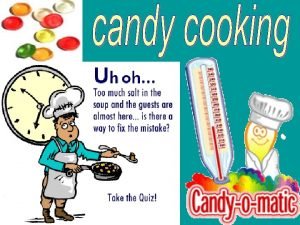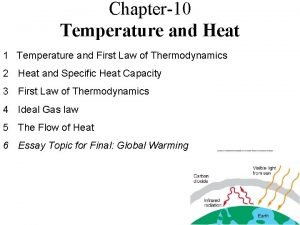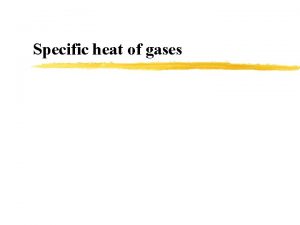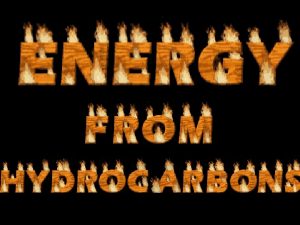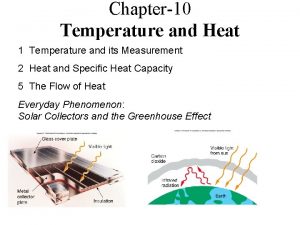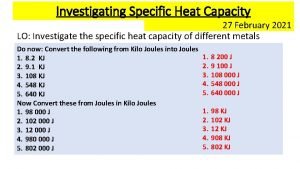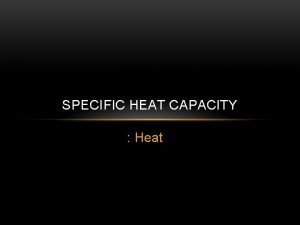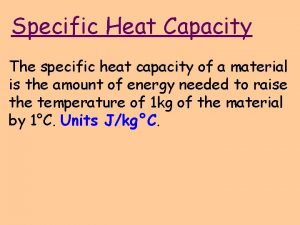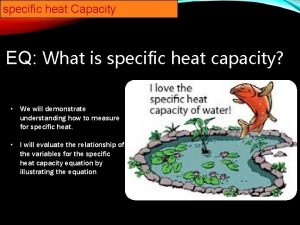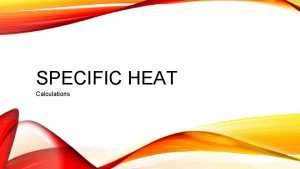Specific heat capacity The heat needed to the







- Slides: 7


Specific heat capacity The heat needed to the temperature of 1 g of a substance by 1 C. Symbol: c, units: J/(g C). Heat capacity The heat needed to the temperature of an object by 1 C. Symbol: C (=c x m), units: J/ C Heat of reaction The heat released during a chemical reaction. Symbol: q, units: J. Specific heat (of reaction) The heat released during a chemical reaction per gram of reactant. Symbol: h, units: J/g. Molar heat of reaction The heat released during a chemical reaction per mole of reactant. Symbol: H, units: J/mol.

Heat Calculations • To determine the amount of heat a substance produces or absorbs we often use q = cm T • q: heat in J, c: specific heat capacity in J/(g C), m: mass in g, T: temperature change in C, • This equation makes sense if you consider units J J= x g x C g C For a list of c values see page 568 (table 3) Sample problem: (must know water = 4. 18 J/g C) When 12 g of a food was burned in a calorimeter, the 100 m. L of water in the calorimeter changed from 20 C to 33 C. Calculate the heat released. q=cm T = 4. 18 J/(g C) x 100 g x 13 C = 5. 4 k. J

More practice 1. 5 g of copper was heated from 20 C to 80 C. How much energy was used to heat the Cu? q=cm T = 0. 38 J/(g C) x 5 g x 60 C = 114 J 2. If a 3. 1 g ring is heated using 10. 0 J, it’s temp. rises by 17. 9 C. Calculate the specific heat capacity of the ring. Is the ring pure gold? q=cm T 10. 0 J c = q/m T= = 0. 18 J/(g°C) 3. 1 g x 17. 9 C The ring is not pure. Gold is 0. 13 J/(g C)

Heat Capacity Calculations • Recall that heat capacity (J/ C) is different from specific heat capacity (J/g C). • Heat capacity is sometimes a more useful value • For example, because a calorimeter includes wires, the stirrer, thermometer, etc. some heat will be transferred to these other materials. • Rather than having to calculate q for each material, a J/ C value is used. Sample problem: q=cm T A calorimeter has a heat capacity of 2. 05 k. J/ C. How much heat is released if the temperature change in the calorimeter is 11. 6 C? q = cm T q= 2. 05 k. J/ C x 11. 6 C = 23. 8 k. J

Thermochemical Equations Thermochemical equations are chemical equations with an added heat term. • KBr. O 3(s) + 42 k. J KBr. O 3(aq) This is endothermic (heat is absorbed/used) • 2 Mg(s) + O 2(g) 2 Mg. O(s) + 1200 k. J This is exothermic (heat is produced/released) Sample problem: 3. 00 g of octane was burned in a calorimeter with excess oxygen, the 1000 m. L of water in the calorimeter rose from 23. 0 C to 57. 6 C. Write thermochemical equation for octane, representing the molar heat of combustion.

Sample: First, calculate the heat released by the combustion reaction via q=cm T … = 4. 18 J/(g C) x 1000 g x 34. 6 C = 144 628 J Octane (C 8 H 18) has a molar mass of 114. 26 g/mol We can determine the molar heat of reaction 1) via the specific heat of reaction or 2) directly h = J = 144 628 J H = 48. 2 k. J x 114. 26 g g 3. 00 g g mol = 48209 J/g = 48. 2 k. J/g = 5508 k. J/mol or J 144 628 J H = = 5508 k. J/mol = mol 0. 0263 mol C 8 H 18 + 12. 5 O 2 8 CO 2 + 9 H 2 O + 5508 k. J


